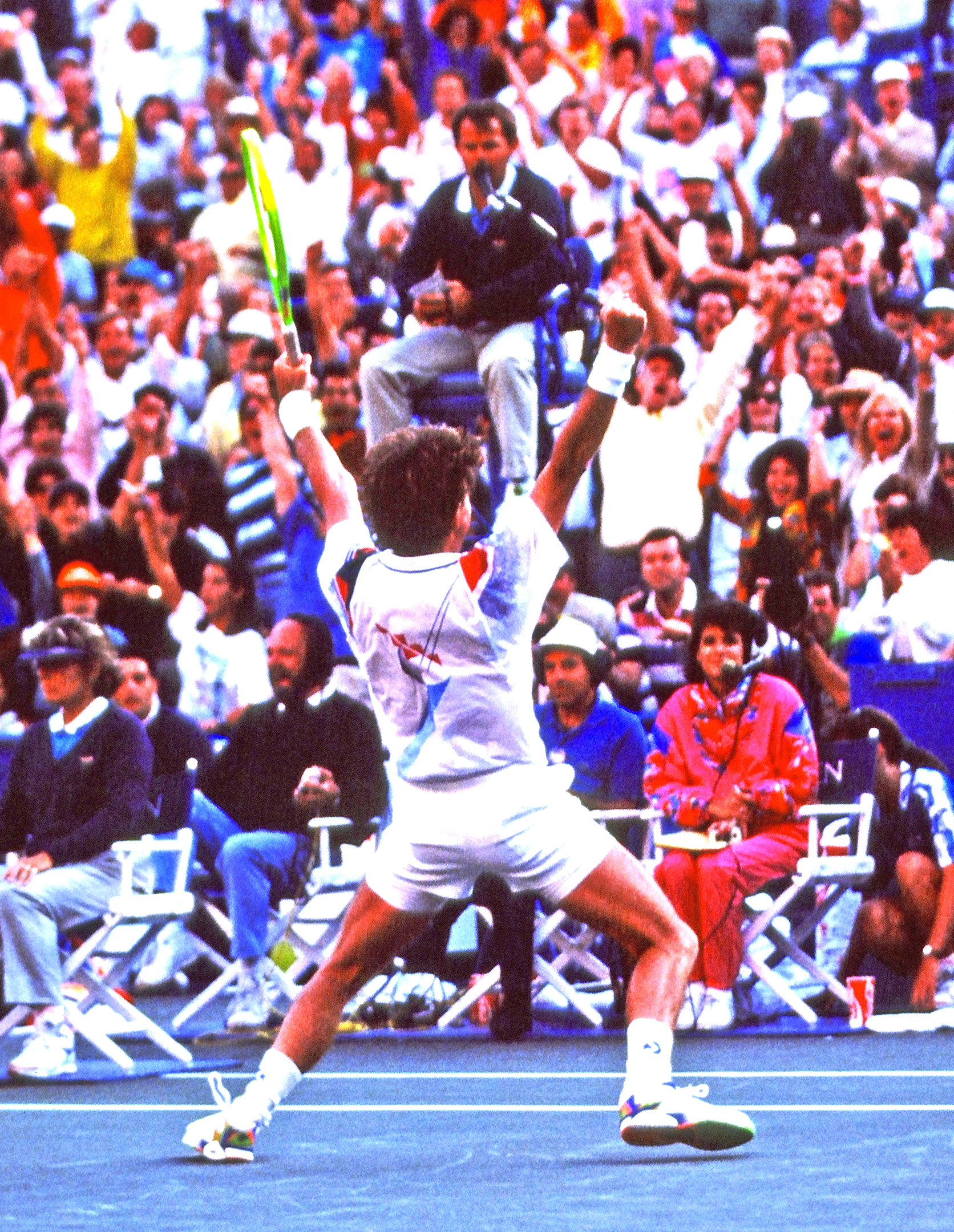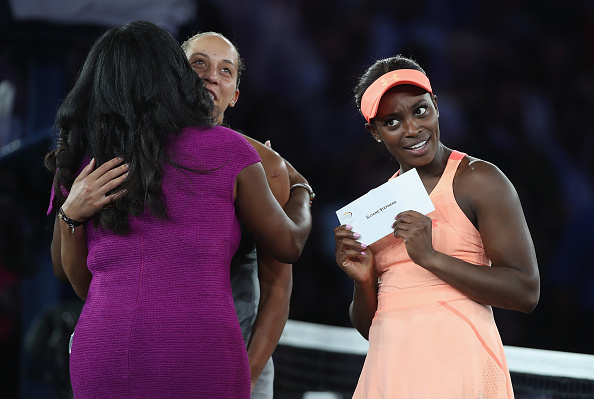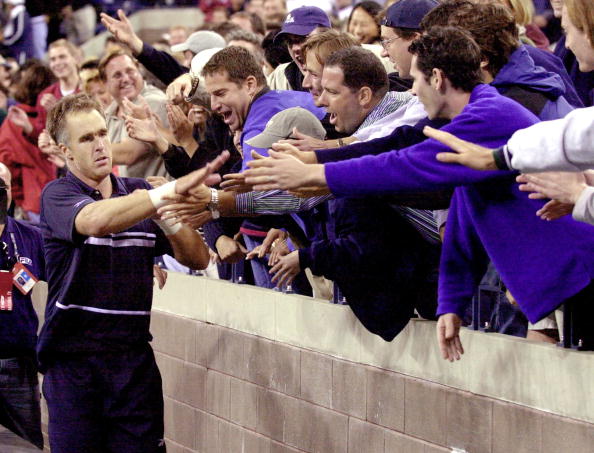Capturing the Essence of 50 Years of the US Open
Bill Simons
From the morning’s sleepy moments until the well-lubricated after-midnight hour, the daily rite unfolds.
There are just two gladiators, small and solitary, battling before 23,473 fans. Where else in sports do you see this?
The US Open is immense. With a nonchalant ease and an in-your-face swagger, it absorbs contradictions and celebrates paradoxes. “Bring it on!”
Where else in sport do you get such an astounding sound switch? In a flash the deafening roar of the throng gives way to an eerie hush. A fierce, sometimes frenetic, athletic exchange unfolds, a mano-o-mano battle that demands power, savvy and subtlety. Bodies are challenged – feel the burn. Minds are tested – tactics change, strategies shift. What to do?
The US Open is quintessential New York combat – raw, brutal, loud and high profile. What happens in New York doesn’t stay in New York. Here, summer heat yields to chill hints of fall. Wall Street power brokers, Jersey kids and Iowa tourists join A-list celebs. There’s Trump peering down from his domain. There’s Clinton chatting with Mac. There’s McCartney way up in a suite. A beaming Aretha waves to adoring fans. Michelle O. is holding court.
While upscale fans sip Chardonnay in plush suites, others chomp on nachos up in row Z. It’s said that the Mir Space Station is almost as close to the action as some of the seats. Many are drawn to raucous battles on the intimate Grandstand. Others trek out to cozy outside courts where America’s next great hope might be emerging.
The Open is an unforgiving mistress. She’ll offer a little come-hither, then give you a swift kick in the pants. You can wait a couple of hours just to get into the place – the lines stretch longer than Federer’s resume. A big hot dog costs a little fortune. Open days can leave you in a daze – high drama is the coinage of this realm.

Fifty years ago, when the US Nationals became the US Open, waifish winner Arthur Ashe collected a measly $280 – enough these days for a decent ticket in section 303 – near Jupiter. In 1979, the Open almost imploded when two of the baddest boys to ever play this gentlemen’s game – nasty Nastase and Superbrat John McEnroe – nearly sparked a riot. The Open humbled a Euro-god. Bjorn Borg, who reached four finals but couldn’t “make it there,” exiting the game without New York glory. In contrast, Jimmy Connors cherished every moment at the Open. Has sports ever given us an actor who more adored his stage than Jimbo in the Big Apple?
No one will ever match his feat of winning the title on grass, clay and hard courts. But it was the sheer bravado of his 1991 “This is what they came for, this is what they want!” run to the semis that changed everything. Just as Babe Ruth brought modern baseball to new heights, so, too, the 39-year-old’s unvarnished passion, his operatic sense of the moment and his over-the-top, not-yet-over-the-hill athleticism suddenly made the Open a must-see, Big Apple happening.
Jimbo’s shameless showmanship prompted Robert Lipsyte’s timeless soliloquy on naughtiness lost: “Connors reminds you all how much we have given up by growing up. Lucky Jimmy. If only we could once again stop the party in the living room, make all the grownups applaud his naughty words, dance through the hors d’oeuvres, posture and preen and be a terrible two, the only time when a human being will be loved for conquering the world while crying.”
****
The Open was built on the site of a World’s Fair, and draws wannabes from Burbank to Beijing who often, but not always, get a fair shake. Hard courts, hard luck, hard cash – it’s as simple as that, buster. After Sloane Stephens won last year a reporter wondered whether she’d still be motivated to win. “Of course, girl,” replied the seldom shy millennial. “Did you see that check that lady handed me? Like, yes! Man, if that doesn’t make you want to play tennis, I don’t know what will.” The winner this year will make almost $3.8 million and a bounty in endorsements.

Yes, the Open enriches – even first-round losers earn a bundle. Still, the Open has soul. As much as any sports event, it challenges us with social statements to muse on. Its prime stadium is named for a cultured pioneer – Arthur Ashe. Its second stadium is named for a cultural icon – Louis “Satchmo” Armstrong. And the tennis center itself is named after a woman who shifted the cultural landscape – Billie Jean.
Here, Ashe once won. Two African-American sisters played in prime time. A Nobel winner, Bishop Tutu, went on his usual charm offensive. A catsuit shocked timid eyes. A peace-loving Pakistani, Aisam-ul-Haq Quereshi, joined with an Indian, Rohan Bopanna, to reach a doubles final. Babs Streisand suggested boy Andre was a Zen master – and she wasn’t that far off.
But that was Zen, this is now. These days, Ashe Stadium has a well-sculpted roof. There’s a fairly new Grandstand, and a dazzling new “Lou” – the 14,000-seat Louis Armstrong Stadium is about to debut. There are fan-friendly practice courts and a huge electronic scoreboard that’s an asymmetrical mix of trendy ads, A-list celebrity sightings and must-see candids that lavish 15 seconds of glory on look-at-me fans who turn showboating into an art form.
The Open is a celebration of unfiltered passion. Connors noted, “New Yorkers love it when you spill your guts out there. You spill your guts at Wimbledon and they make you stop and clean it up.”
Ultimately, the greatest thing about the Open is that it’s open: open to a Scot’s ambition. Open to a Californian’s dreams. Open to shock results – goodness, last year Stephens won out of nowhere. It gives us sonatas of athletic grace – the balletic Federer has lifted the trophy five times. It showcases fierce rivalries: Borg vs. McEnroe, Chrissie vs. Martina, McEnroe vs. Lendl, Andre vs. Pete. (Amazingly, Roger and Rafa have never met in NYC.)

At the Open we welcome the unexpected: a triumphant Todd Martin circles the grandstand. offering high-fives to one and all. And New York night tennis takes the game to a different stratosphere.
Not surprisingly, the Open has long given us controversy. Serena confronted a lineswoman. Young Lleyton Hewitt offered a racist critique. Here, rants are loud, rogues are plentiful, and poignant moments become favored memories: Connors’ young son comforting his vanquished dad; toddler Jada Clijsters winning our hearts as she’s stunned to see her own image on the huge scoreboard. Young, vulnerable, defeated Martina being embraced by the compassionate crowd. The aging Chrissie offering a final, graceful wave goodbye. And Andre who-knew-he-could-be-so-eloquent Agassi tapping his inner Lou Gehrig to give a pitch-perfect farewell address that induced tears.
Ultimately, the Open opens tennis up to a world of potential. A unique sporting canvas, it magnifies the game and puts it on a pedestal. Here, as Justine Henin told us, “Impossible is nothing.” As summer wanes, imaginations soar. Now we celebrate 50 years of wonder at an event that’s far bigger than a New York moment, a tournament that has elevated the spirit and created a legacy that, like few others, continues to inspire.



















